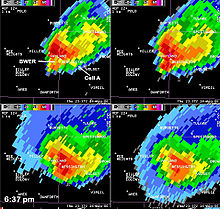|
Bounded weak echo region The bounded weak echo region, also known as a BWER or a vault, is a radar signature within a thunderstorm characterized by a local minimum in radar reflectivity at low levels which extends upward into, and is surrounded by higher reflectivities aloft, forming a kind of dome of weak echoes. This feature is associated with a strong updraft and is almost always found in the inflow region of a thunderstorm: it cannot be seen visually.[1] The BWER has been noted on radar imagery of severe thunderstorms since 1973 and has a lightning detection system equivalent known as a lightning hole.[2] Description and attributes The BWER is a nearly vertical channel of weak radar echo, surrounded on the sides and top by significantly stronger echoes. The BWER, sometimes called a vault, is related to the strong updraft in a severe convective storm that carries newly formed atmospheric particulates, called hydrometeors, to high levels before they can grow to radar-detectable sizes. BWERs are typically found at mid-levels of convective storms, 3 kilometres (1.9 mi) to 10 kilometres (6.2 mi) above the ground, and are a few kilometers in horizontal diameter.[3] Identifying the location of the updraft region is important because it is linked to locations where severe weather normally occurs.[4] The presence of a BWER has been part of a method to diagnose thunderstorm strength as part of the Lemon technique since 1977.[5] The updraft strength within the BWER supports the growth of large hailstones just above the vault, which is displaced slightly into the direction of motion of the parent supercell storm.[6] Detection The bounded weak echo region (BWER) is a region of low radar reflectivity bounded above by an area of higher radar reflectivity which shows evidence of a strong updraft within mesocyclones. Radar analysts have recognized this phenomenon since at least 1973,[7] using different elevation scans. Methods of objectively corroborating that a BWER is associated with a mesocyclone involve using a weather radar with the Doppler effect to obtain the precipitation velocities. This have been available operationally in United States since 1997 with the NEXRAD network.[8] When using the lightning detection system, lightning holes (uncovered in 2004) correspond to where a BWER would be seen on radar.[2] A cross-section of the three-dimensional reflectivity of a thunderstorm shows the vault better. Algorithms were developed by the J.S. Marshall Radar Observatory of McGill University in Canada to locate the overhang region in a thunderstorm by the late 1980s.[9][10][11][12] Its radar uses 24 angles, giving it good vertical resolution.[13] In the United States, fewer scanning angles are made within the WSR-88D radar, which makes it more difficult to detect the overhang.[14][15] Once the overhang is located, it is possible to make a cross-section to view if it is related with a BWER.[16] However, since 1997, algorithms have been developed by the National Weather Service to determine regions of reflectivity gradient in three dimensions and the presence of BWER in convection.[17] The development of a pronounced BWER can lead to tropical cyclone-like radar signatures over land when located with a low angle plan position indicator (PPI).[18][19] In the lightning detection system, lightning holes (uncovered in 2004) correspond to locations where a BWER would appear on radar.[2] See alsoReferences
External links
|